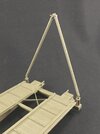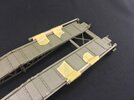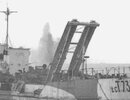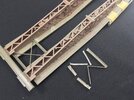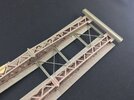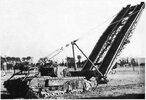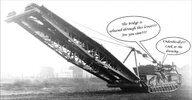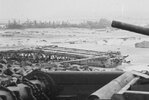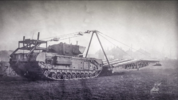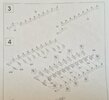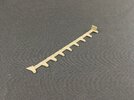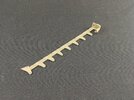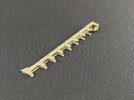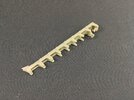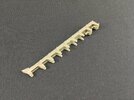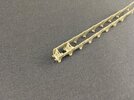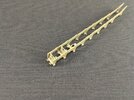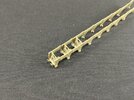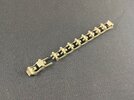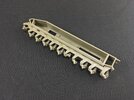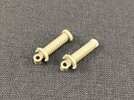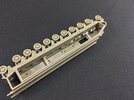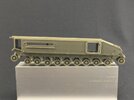- Joined
- Apr 28, 2018
- Messages
- 10,889
- Points
- 113
- First Name
- Jakko
The bridge itself is now just about done:
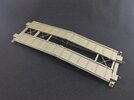
To attach the decks, it works best if you put them on the girders a few centimetres away from the bridge’s centre, because the girders there are a bit too thick for the deck pieces to fit over them easily. Then just slide up to the middle and run glue into the joints.
There are some kind of grips/levers/thingies on the bridge, four to each deck, but one had gone missing from a sprue, so I had to fabricate a replacement:
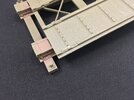
This is just two 1.6 mm discs punched out of 0.25 mm plastic card, with the top disc having its centre cut away so that there’s a groove down the middle. The handle itself is a piece of stretched plastic rod (like sprue, except I had reason to stretch some plastic rod the other day to obtain a cone, so I used the thin bit I had left over for this).
At the “tank end” of the bridge are two pedestals for the booms by which the bridge was winched up:
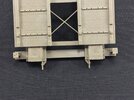
The holes in them are for hinges for the booms, so they will fall away from the bridge deck when it’s laid.
However, AFV Club made a pretty major mistake here. Take a look at the instructions:
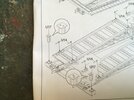
Both of them are labelled as part U17, and the instructions clearly point out which way the holes should face. Unfortunately, you can’t make it like that because if you turn U17 through 90 degrees it won’t fit, and if you cut off its locating pin so you can turn it, it will still be wrong (the top plate is not square and the angle of the holes would be incorrect).
I solved this by cutting off the top, filing everything square and flat, adding some plastic card, and re-attaching the top upside-down:
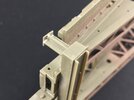
… and when writing this, of course, I discovered that the fix is far simpler … use part U6 So the instructions are wrong, the right part is on the sprue, but I had overlooked it because they’re a little confusing. Anyway, I’ll keep what I have, as it fits fine.
So the instructions are wrong, the right part is on the sprue, but I had overlooked it because they’re a little confusing. Anyway, I’ll keep what I have, as it fits fine.

To attach the decks, it works best if you put them on the girders a few centimetres away from the bridge’s centre, because the girders there are a bit too thick for the deck pieces to fit over them easily. Then just slide up to the middle and run glue into the joints.
There are some kind of grips/levers/thingies on the bridge, four to each deck, but one had gone missing from a sprue, so I had to fabricate a replacement:

This is just two 1.6 mm discs punched out of 0.25 mm plastic card, with the top disc having its centre cut away so that there’s a groove down the middle. The handle itself is a piece of stretched plastic rod (like sprue, except I had reason to stretch some plastic rod the other day to obtain a cone, so I used the thin bit I had left over for this).
At the “tank end” of the bridge are two pedestals for the booms by which the bridge was winched up:

The holes in them are for hinges for the booms, so they will fall away from the bridge deck when it’s laid.
However, AFV Club made a pretty major mistake here. Take a look at the instructions:

Both of them are labelled as part U17, and the instructions clearly point out which way the holes should face. Unfortunately, you can’t make it like that because if you turn U17 through 90 degrees it won’t fit, and if you cut off its locating pin so you can turn it, it will still be wrong (the top plate is not square and the angle of the holes would be incorrect).
I solved this by cutting off the top, filing everything square and flat, adding some plastic card, and re-attaching the top upside-down:

… and when writing this, of course, I discovered that the fix is far simpler … use part U6
 So the instructions are wrong, the right part is on the sprue, but I had overlooked it because they’re a little confusing. Anyway, I’ll keep what I have, as it fits fine.
So the instructions are wrong, the right part is on the sprue, but I had overlooked it because they’re a little confusing. Anyway, I’ll keep what I have, as it fits fine.

 Though it won’t be very much longer …
Though it won’t be very much longer …
